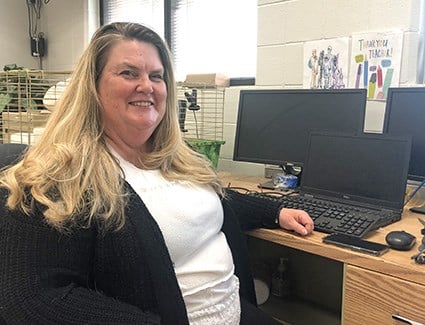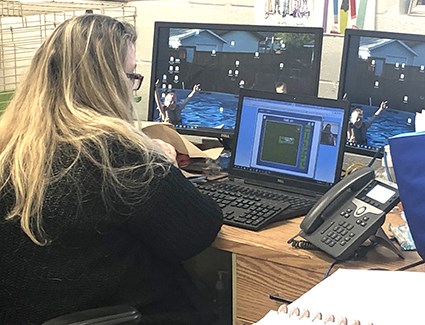 "Are you ready to do a bit of work?" resource teacher Lana Abercrombie asks the student whose face is on her computer screen.
"Are you ready to do a bit of work?" resource teacher Lana Abercrombie asks the student whose face is on her computer screen.
The one-on-one virtual session is one of several half-hour periods Abercrombie spends with students each day as they learn, connect, and talk about their lives as part of an online classroom for Functional Life Skills (FLS) students and other students with individual needs.
On this afternoon, she patiently guides the student through reading and comprehension of a list of 100 functional words. Salary, hazard, and occupation are some of the terms on their shared screen.
For the past two school years Abercrombie's middle years and high school age students have gathered each morning in their virtual classroom as they remain connected to learning and school in the face of the COVID-19 pandemic.
"The thing that is really cool is the connection between the kids is just like a normal class," Abercrombie said. "None of them have met in person, none of them know each other in person, but they have those connections. They remember things about each other. I think it is because they are together every day. We try to get them to talk to one another. We do show and share, we have fun days. You will see them helping each other; I hear kids give each other hints."
The online class was created at the beginning of the 2020-21 school year to meet the needs of students who are immunocompromised or have other needs that made in-person learning during a pandemic a challenge. Sixteen students were part of a FLS-specific class last year. Five students from that class continued online learning into the current school year and were joined by other students to create a classroom that includes students with a variety of individual needs. Now, with the pandemic waning, the online program won't be offered for 2022-23 and students transition back to in-person learning.
Abercrombie's virtual classroom has 10 students ranging in age from 10 to 22, all with intellectual disabilities along with other exceptionalities such as autism, visual impairment, or hearing impairment. Some are minimally speaking and require the use of technology to communicate their needs, wants, and opinions.
She teaches functional (practical) academics and develops learning tasks that build students' daily living skills and provide opportunities for practice when they aren't on screen with her.
Each school day begins with a session that includes all students. After a short recess, Abercrombie connects individually to work on specific goals or needs during the course of the day.
 "We have an hour zoom per day where everybody is there — if I go five minutes over, they are getting tired," she said. "Then I have a little bit of a break and the rest of the day is three or four half-hour sessions where I see kids individually. That seems to work with them — and their parents have said it works for them — because some students have physical needs that need to be taken care of too.
"We have an hour zoom per day where everybody is there — if I go five minutes over, they are getting tired," she said. "Then I have a little bit of a break and the rest of the day is three or four half-hour sessions where I see kids individually. That seems to work with them — and their parents have said it works for them — because some students have physical needs that need to be taken care of too.
"When I first started, I honestly didn't know what I was going to do. Our goal is engaging them, keeping them connected to a teacher as well as working on skills, but the important thing is keeping them connected. In the beginning, it was a lot of 'give me a thumbs up' because I couldn't sit and wait for 16 people to answer a question."
Unlike most classrooms, students are welcome to call out or interrupt during learning. Abercrombie makes a conscious effort to pay attention to each student. That way, if they drift away or become distracted, she is able to bring them back into what is taking place in class. Sometimes parents are present in the background, but as the classroom relationship developed parents felt comfortable enough to not be there all of the time.
Abercrombie hasn't been able to use many of the methods or resources that have been go-to materials at other times during her teaching career. When it comes to teaching tools, books and white boards aren't practical for virtual learning with students who access the class on devices ranging from iPad minis to desktop computers. Instead, she engages students through videos, boom cards, Google slides, virtual field trips, guest speakers and yes, even chickens.
Like in-person classrooms throughout the school division, the online students watched the eggs in Abercrombie's classroom hatch and the tiny chicks grow into active birds that ran around a converted child's swimming pool. A camera allowed Abercrombie to show students their growth in real time, and chick-care support from students in the FLS program at Marion Graham allowed her to teach at the same time. A couple of her students even came to the school to meet the chicks.
While most teacher-student interactions take place through a screen, Abercrombie has met her students in person. She has delivered special projects — such as a "Dad you Rock" craft that students put together for Father's Day or heart-shaped string art for moms — to the homes of students. Then, they are able to work on them together during their virtual session.
"A lot of the kids like the artistic, creative stuff," she said. "We have done different academic tasks —some of them will do it, not all of them — but for a more creative thing they are all into it. Some of those projects are really good for learning how to follow directions, listening, dexterity. Some of the students have never hammered a nail before."
Megan Larson-Wilkie, a special education consultant with the division, said parents have been pleased with Abercrombie's programming and report significant growth in their children's skills with communication, independence, and academics. Students have been engaged in the learning and parents are then able to reinforce the concepts being taught.
"We aren't aware of many other jurisdictions who have offered programming to this extent and for this duration of time for students, and there is limited research on best practices for virtual learning for students with significant disabilities. The learning experience Lana has provided is truly innovative," Larson-Wilkie said.
The experience of teaching FLS and students with special needs in an online format has been a challenge, Abercrombie admits. An important aspect of the program is helping students learn how to be in community and sharing the social, life, and vocational skills that will support them in the future, something that can be difficult to convey virtually.
But given the circumstances, the opportunity to keep students connected and safe during two years of learning during a pandemic has been a positive experience for students and teacher alike, Abercrombie believes.
"When I think about this job, it became what it has become because of the kids and the parents. It's not really me, it's them on the other end. They have made it what it is. They (the students) are there all of the time."